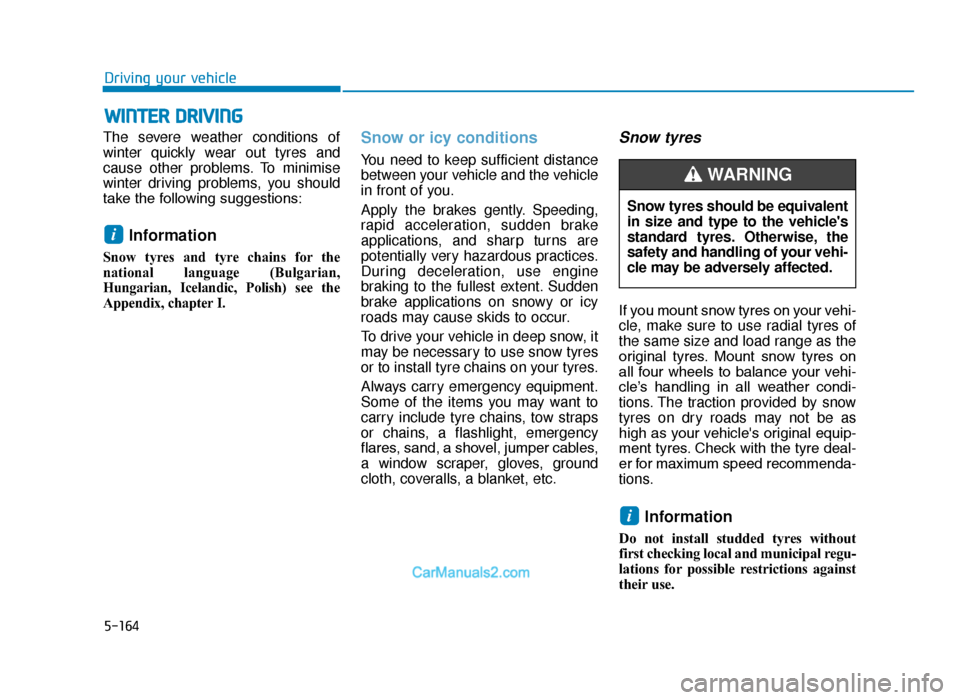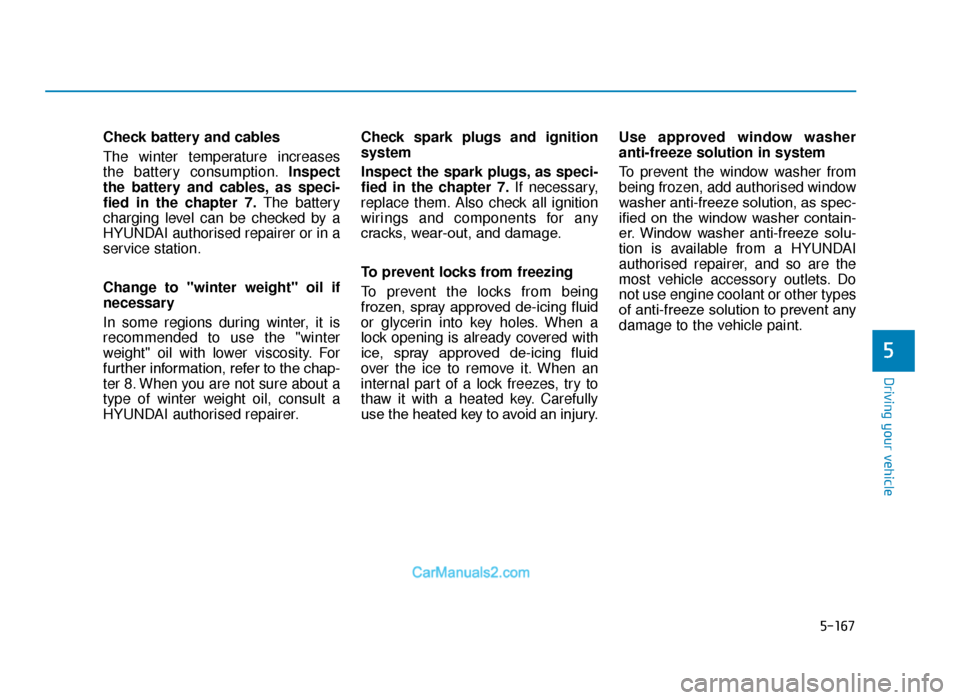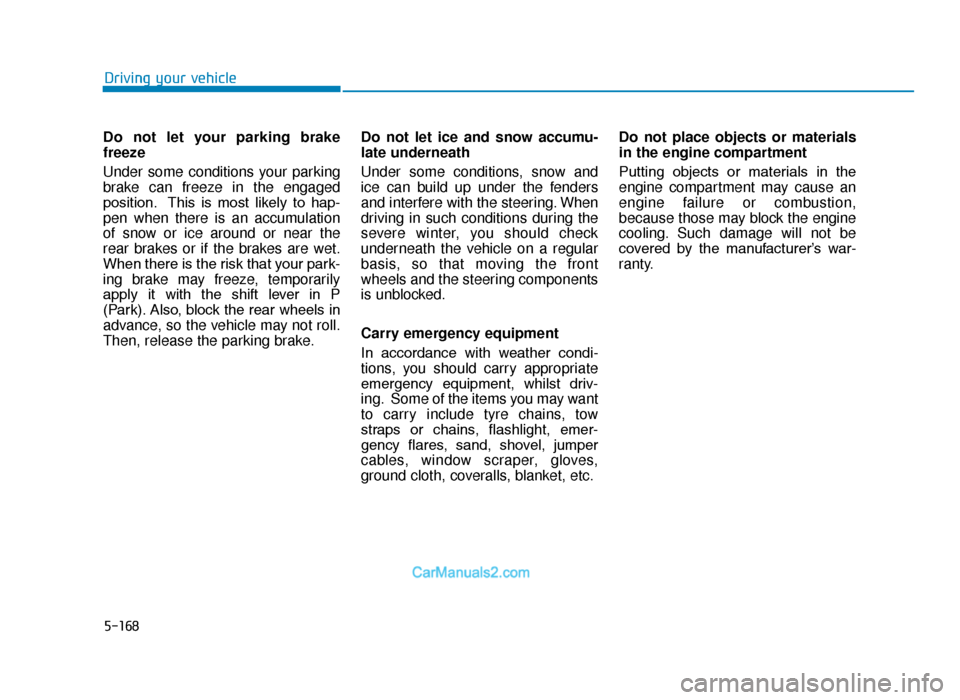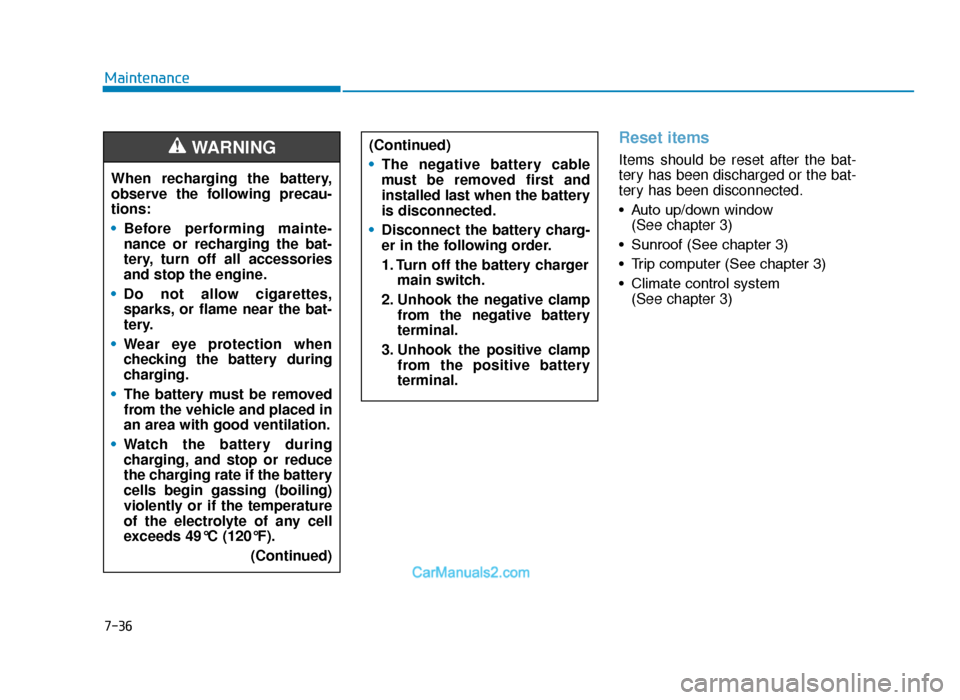Page 488 of 685

5-164
Driving your vehicle
The severe weather conditions of
winter quickly wear out tyres and
cause other problems. To minimise
winter driving problems, you should
take the following suggestions:
Information
Snow tyres and tyre chains for the
national language (Bulgarian,
Hungarian, Icelandic, Polish) see the
Appendix, chapter I.
Snow or icy conditions
You need to keep sufficient distance
between your vehicle and the vehicle
in front of you.
Apply the brakes gently. Speeding,
rapid acceleration, sudden brake
applications, and sharp turns are
potentially very hazardous practices.
During deceleration, use engine
braking to the fullest extent. Sudden
brake applications on snowy or icy
roads may cause skids to occur.
To drive your vehicle in deep snow, it
may be necessary to use snow tyres
or to install tyre chains on your tyres.
Always carry emergency equipment.
Some of the items you may want to
carry include tyre chains, tow straps
or chains, a flashlight, emergency
flares, sand, a shovel, jumper cables,
a window scraper, gloves, ground
cloth, coveralls, a blanket, etc.
Snow tyres
If you mount snow tyres on your vehi-
cle, make sure to use radial tyres of
the same size and load range as the
original tyres. Mount snow tyres on
all four wheels to balance your vehi-
cle’s handling in all weather condi-
tions. The traction provided by snow
tyres on dry roads may not be as
high as your vehicle's original equip-
ment tyres. Check with the tyre deal-
er for maximum speed recommenda-
tions.
Information
Do not install studded tyres without
first checking local and municipal regu-
lations for possible restrictions against
their use.
i
i
WINTER DRIVING
Snow tyres should be equivalent
in size and type to the vehicle's
standard tyres. Otherwise, the
safety and handling of your vehi-
cle may be adversely affected.
WARNING
TLe UK 5.qxp 5/10/2018 12:32 PM Page 164
Page 491 of 685

5-167
Driving your vehicle
5
Check battery and cables
The winter temperature increases
the battery consumption.Inspect
the battery and cables, as speci-
fied in the chapter 7. The battery
charging level can be checked by a
HYUNDAI authorised repairer or in a
service station.
Change to "winter weight" oil if
necessary
In some regions during winter, it is
recommended to use the "winter
weight" oil with lower viscosity. For
further information, refer to the chap-
ter 8. When you are not sure about a
type of winter weight oil, consult a
HYUNDAI authorised repairer. Check spark plugs and ignition
system
Inspect the spark plugs, as speci-
fied in the chapter 7.
If necessary,
replace them. Also check all ignition
wirings and components for any
cracks, wear-out, and damage.
To prevent locks from freezing
To prevent the locks from being
frozen, spray approved de-icing fluid
or glycerin into key holes. When a
lock opening is already covered with
ice, spray approved de-icing fluid
over the ice to remove it. When an
internal part of a lock freezes, try to
thaw it with a heated key. Carefully
use the heated key to avoid an injury. Use approved window washer
anti-freeze solution in system
To prevent the window washer from
being frozen, add authorised window
washer anti-freeze solution, as spec-
ified on the window washer contain-
er. Window washer anti-freeze solu-
tion is available from a HYUNDAI
authorised repairer, and so are the
most vehicle accessory outlets. Do
not use engine coolant or other types
of anti-freeze solution to prevent any
damage to the vehicle paint.
TLe UK 5.qxp 5/10/2018 12:32 PM Page 167
Page 492 of 685

5-168
Driving your vehicle
Do not let your parking brake
freeze
Under some conditions your parking
brake can freeze in the engaged
position. This is most likely to hap-
pen when there is an accumulation
of snow or ice around or near the
rear brakes or if the brakes are wet.
When there is the risk that your park-
ing brake may freeze, temporarily
apply it with the shift lever in P
(Park). Also, block the rear wheels in
advance, so the vehicle may not roll.
Then, release the parking brake. Do not let ice and snow accumu-
late underneath
Under some conditions, snow and
ice can build up under the fenders
and interfere with the steering. When
driving in such conditions during the
severe winter, you should check
underneath the vehicle on a regular
basis, so that moving the front
wheels and the steering components
is unblocked.
Carry emergency equipment
In accordance with weather condi-
tions, you should carry appropriate
emergency equipment, whilst driv-
ing. Some of the items you may want
to carry include tyre chains, tow
straps or chains, flashlight, emer-
gency flares, sand, shovel, jumper
cables, window scraper, gloves,
ground cloth, coveralls, blanket, etc.Do not place objects or materials
in the engine compartment
Putting objects or materials in the
engine compartment may cause an
engine failure or combustion,
because those may block the engine
cooling. Such damage will not be
covered by the manufacturer’s war-
ranty.
TLe UK 5.qxp 5/10/2018 12:32 PM Page 168
Page 581 of 685
7-32
Maintenance
Rear window wiper blade
1. Raise the wiper arm and pull outthe wiper blade assembly. 2. Install the new blade assembly by
inserting the centre part into the
slot in the wiper arm until it clicks
into place.
3. Make sure the blade assembly is installed firmly by trying to pull it
slightly.
To prevent damage to the wiper arms
or other components, we recommend
that the wiper blade be replaced by a
HYUNDAI authorised repairer.
OTL075050
OTL075051
TLe UK 7.qxp 5/10/2018 1:34 PM Page 32
Page 585 of 685

7-36
Maintenance
Reset items
Items should be reset after the bat-
tery has been discharged or the bat-
tery has been disconnected.
• Auto up/down window (See chapter 3)
• Sunroof (See chapter 3)
• Trip computer (See chapter 3)
• Climate control system (See chapter 3)
(Continued)
•
The negative battery cable
must be removed first and
installed last when the battery
is disconnected.
• Disconnect the battery charg-
er in the following order.
1. Turn off the battery charger
main switch.
2. Unhook the negative clamp from the negative battery
terminal.
3. Unhook the positive clamp from the positive battery
terminal.
When recharging the battery,
observe the following precau-
tions:
•Before performing mainte-
nance or recharging the bat-
tery, turn off all accessories
and stop the engine.
• Do not allow cigarettes,
sparks, or flame near the bat-
tery.
• Wear eye protection when
checking the battery during
charging.
• The battery must be removed
from the vehicle and placed in
an area with good ventilation.
• Watch the battery during
charging, and stop or reduce
the charging rate if the battery
cells begin gassing (boiling)
violently or if the temperature
of the electrolyte of any cell
exceeds 49°C (120°F).
(Continued)
WARNING
TLe UK 7.qxp 5/10/2018 1:34 PM Page 36
Page 607 of 685
7-58
Maintenance
Driver’s side fuse panel
Fuse Name SymbolFuse RatingCircuit Protected
A/CON 2 7.5A A/C Control Module
HEATED
MIRROR 10A Driver/Passenger Power Outside Mirror, A/C Control Module, ECM/PCM
P/SEAT (DRV) 30A Driver Seat Manual Switch
SAFETY
P/WINDOW DRV25A Driver Safety Power Window Module
P/WINDOW RH 25A Power Window Main Switch, Passenger Power Window Switch
SAFETY
P/WINDOW PASS25APassenger Safety Power Window Module
P/ WINDOW LH 25A Power Window Main Switch, Passenger Power Window Switch
TLe UK 7.qxp 5/10/2018 1:36 PM Page 58
Page 609 of 685
7-60
Maintenance
Engine compartment main fuse panel (Petrol Engine)
Fuse Name SymbolFuse ratingCircuit Protected
MULTIFUSE
POWER
STEERING111100AMDPS Unit
POWER
STEERING21280AMDPS Unit
B+ 1 60A Smart Junction Block (IPS1, IPS2, IPS3, IPS4, Fuse - F50)
B+ 2 60A Smart Junction Block (IPS5, IPS6, IPS7, IPS8, IPS9, Fuse - F19/F28/F35/F42)
B+ 3 50A Smart Junction Block (Fuse - F23/F32/F39/F41/F46/F48, Power Window Relay)
ABS 1 40A ESP Control Module, ABS Control Module
ABS 2 40A ESP Control Module, ABS Control Module
IG1 40A W/O Smart Key : Ignition Switch, With Smart Key : PCB Block (PDM (IG1) Relay,
PDM (ACC) Relay)
IG2 30A W/O Smart Key : Ignition Switch, With Smart Key : PCB Block (PDM (IG2) Relay)
FUSE
B+ 4 50A Smart Junction Block (Fuse - F14/F21/F22/F31/F38/F45, Leak Current Autocut
Device)
COOLING FAN1(50A)[60A](G4NA/G4FD/G4KJ) : E/R Junction Block (RLY. 1, RLY. 9)
(G4FJ) : E/R Junction Block (RLY. 1)
TLe UK 7.qxp 5/10/2018 1:37 PM Page 60
Page 611 of 685
Maintenance
7-62
Engine compartment main fuse panel (Diesel Engine)
Fuse Name SymbolFuse ratingCircuit Protected
MULTIFUSE
POWER
STEERING111100AMDPS Unit
POWER
STEERING21280AMDPS Unit
B+ 1 60A Smart Junction Block (IPS1, IPS2, IPS3, IPS4, Fuse - F50)
B+ 2 60A Smart Junction Block (IPS5, IPS6, IPS7, IPS8, IPS9, Fuse - F19/F28/F35/F42)
B+ 3 50A Smart Junction Block (Fuse - F23/F32/F39/F41/F46/F48, Power Window Relay)
ABS 1 40A ESP Control Module, ABS Control Module
ABS 2 40A ESP Control Module, ABS Control Module
IG1 40A W/O Smart Key : Ignition Switch, With Smart Key : PCB Block (PDM (IG1) Relay,
PDM (ACC) Relay)
IG2 30A W/O Smart Key : Ignition Switch, With Smart Key : PCB Block (PDM (IG2) Relay)
GLOW PLUG80AGlow Relay Unit
PTC 1
HEATERPTCHEATER150AE/R Junction Block (RLY. 6)
PTC 2
HEATERPTCHEATER250AE/R Junction Block (RLY. 5)
PTC 3
HEATERPTCHEATER350AE/R Junction Block (RLY. 4)
TLe UK 7.qxp 5/10/2018 1:37 PM Page 62